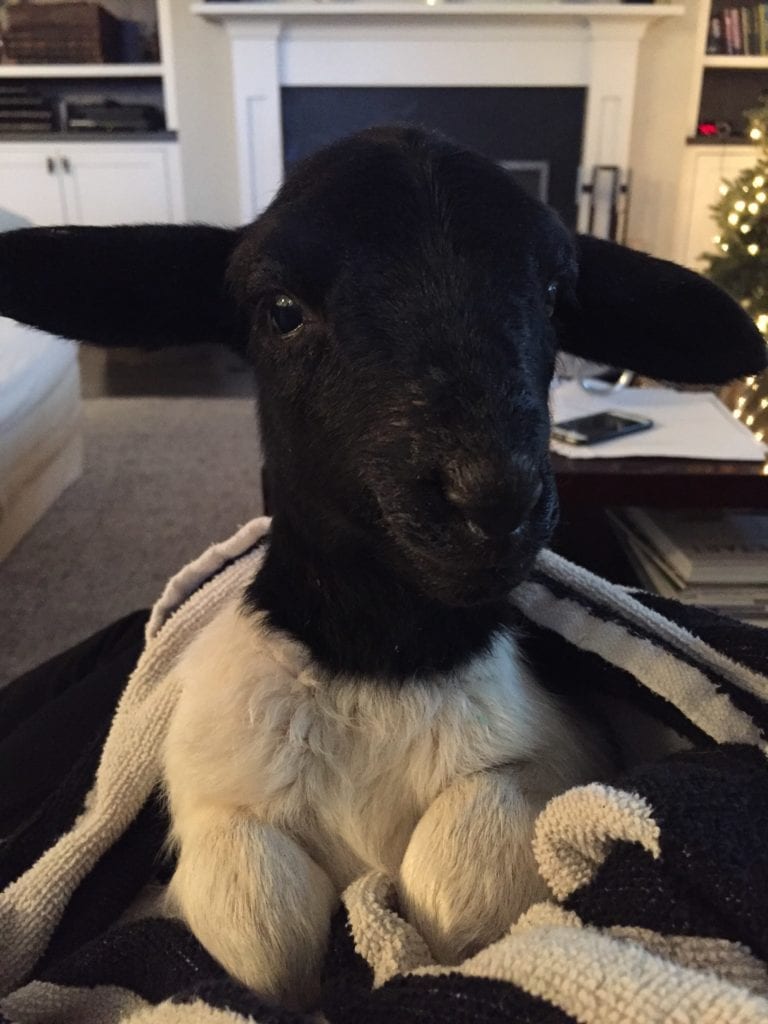
Lamby
A Very Cold Start to Life
One morning last February, we had a nasty ice storm. Everything closed (it’s Texas), so I stayed home and ventured out to help my husband feed the animals and make sure they were all safe. As I hurried past the open pole barn, protecting my face against the sleet blowing in my face, I somewhat noticed our two Great Pyrenees sniffing the ground just inside the fenced area in the pole barn. I continued on to the barn to help load the feed into the mule. As I headed back to the pole barn to put feed out for the sheep, I noticed the Pyrs were still very intent on something in the corner against the cross fencing. Once inside the barn and out of the sleet, I was finally able to focus on what the dogs were up to. Much to my amazement, I saw a tiny little lamb, and then another! One of our ewes had just had twin lambs, and the Pyrs were doing “clean up”. Concerned about the freezing temperature and the newborn lambs, we quickly turned our attention to readying the sheltered pen next to the barn, adding blankets to block the wind from the north, a bucket of feed and hay, some fresh water, and a heat lamp. Next we had to lure mama and her lambs to the pen. Sounds easier than it was.
I got one lamb, my husband the other, and we would walk towards the pen a bit, then show mama the lamb so she would follow, and so on. While I carried my lamb, I tucked her into my coat to project her from the awful wet cold and pelting ice. We finally got all three in the pen, but were quickly dismayed to observe mama rejecting the smaller of the twins, aggressively pushing her away each and every time she tried to nurse. It was hard to watch. We tried everything we could think of, but to no avail. The ewe was a first time mom, with twins handled by humans, on a cold icy morning. We guess one or more of those elements proved more than she could handle.
Lamb Ambulance = L’Ambulance
We gave up trying to force nature, and brought the rejected lamb to the house for warmth and nourishment. We took a large pink plastic storage bin, put some old towels in the bottom, cut a huge hole in the top for air and voila — the L’Ambulance. We kept her in the laundry room the first couple nights, then the mudroom when it warmed up a bit.
She took her bottle like a champ, once we slashed the tip of the nipple to allow the milk to flow more liberally to keep up with her appetite. Every two hours we were making another bottle or two for little Lamby, that night and for the next couple weeks. Yes, we named her Lamby. If you bottle feed a lamb, it’s nearly impossible to avoid attachment.
Graduating to the L’Apartment
After a couple weeks, the weather warmed and Lamby grew, so we brought one of the dog kennels to the front yard, complete with an igloo dog house with straw inside for shelter and warmth. We transitioned Lamby to the kennel, letting her roam a bit in the yard and pastures when supervised between bottle feedings. She loved hanging out on the front porch, and following us around while we did feeding chores. We loved watching her little tail wag feverishly as she took her bottles and as we wiped the milk foam from the sides of her mouth.
Not a Dog
One night, I was sitting on the front porch feeding Lamby her last bottle for the night at around 11 pm. The coyotes started yipping in the distance, and the dogs whipped their heads around, started barking and took off running towards the front gate. Lamby whipped her head around and took off running. The barking was all that was missing in her mimicry of the dogs’ behavior. I went inside the house and told my husband: “Lamby thinks she’s a dog, we need to remind her she’s a lamb.” The next day, we relocated L’Apartment to an area near the barn and just on the other side of the fence where the flock was then residing. We encouraged her to spend time with the flock during the day, and secured her in the L’Apartment each night to keep her safe. We brought her bottles to her, wherever she was. When she was in the pasture with the other sheep, all we had to do was call “Lammmbbyyyy…”, and she’d come running across the pasture for her milk. She soon seemed to be just as content with the flock as she was with us or the dogs. Mission complete.
Coming of Age
Our lambs typically sell within days of being born, but they don’t leave the ranch until they are at least 5 months old and fully weaned. Lamby successfully weaned off milk at around 4 months, and was quite the rolly polly. We wanted to keep her, but instead found her a great new home with a family with two little girls who were excited to be getting a people friendly lamb to raise as a breeding ewe. We miss her very much.
